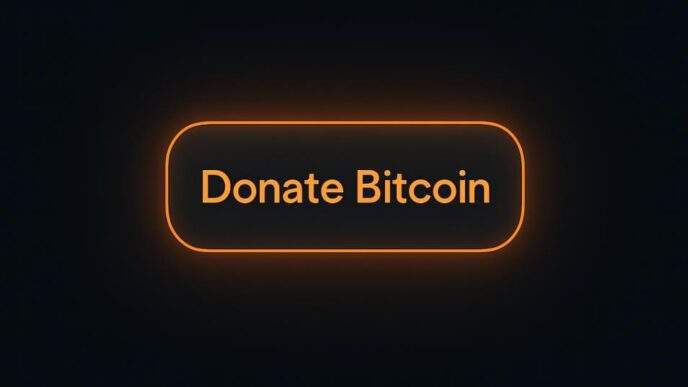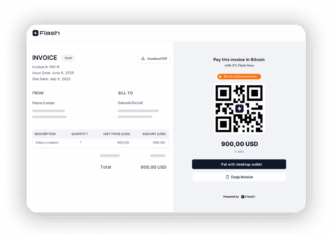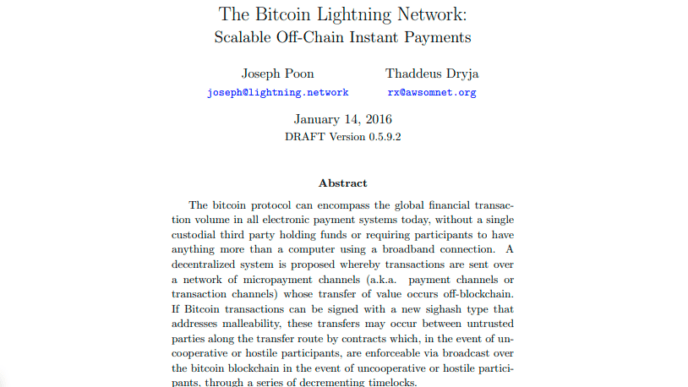Picture this: you’re trying to buy coffee with Bitcoin, but instead of waiting 10 minutes for blockchain confirmation and paying $5 in fees, your transaction completes instantly for a fraction of a penny.
That’s the promise of the Lightning Network, Bitcoin’s most ambitious scaling solution.
But here’s the thing that most people don’t realize – the entire system only works because of an intricate web of technical standards that most users never see.
These standards, known as BOLTs (Basis of Lightning Technology), are the invisible foundation that makes Lightning’s magic possible. Without them, we’d have a fragmented mess of incompatible systems rather than the seamless payment network that’s processing millions of transactions today.
The Protocol Puzzle: Why Lightning Needed Standards
When Lightning Network was first conceived in 2015, it faced a classic chicken-and-egg problem. Multiple development teams were working on implementations – Lightning Labs with LND, Blockstream with c-lightning, and ACINQ with Eclair – but they all had slightly different ideas about how things should work. Without coordination, these would have become isolated islands of functionality.
Think about the early days of instant messaging, when AOL Instant Messenger users couldn’t talk to Yahoo Messenger users. That’s exactly what Lightning developers wanted to avoid. The solution was BOLT – a comprehensive set of technical specifications that would ensure any Lightning implementation could talk to any other, regardless of who built it.
The first BOLT specifications emerged in 2016, but they weren’t just academic exercises. These documents had to solve real engineering challenges: How do you route payments through a network of payment channels? How do you ensure privacy when every transaction could potentially be monitored? How do you handle the inevitable network failures and channel closures?
Inside the BOLT Specifications: A Technical Breakdown
The BOLT specifications read like a blueprint for building a parallel financial system. Each document tackles a specific piece of the Lightning puzzle, and together they create something remarkably sophisticated.
BOLT #1 establishes the foundation – the basic message formats and communication rules that every Lightning node must understand. It’s like defining the grammar of a new language that computers use to talk about money. This specification covers everything from how nodes identify themselves to the basic structure of Lightning messages.
BOLT #2 gets into the nitty-gritty of channel management, the heart of Lightning’s functionality. Payment channels are essentially shared cryptocurrency wallets between two parties, and managing them securely requires incredibly precise coordination. This specification defines exactly how nodes negotiate channel parameters, handle updates, and gracefully close channels when needed. One wrong step here, and funds could be lost forever.
The routing problem gets its due attention in BOLT #4, which implements something called “onion routing” – the same privacy technique used by Tor. When you send a Lightning payment, each node in the path only knows the previous and next hop, never the full route. The sender wraps the payment instructions in multiple layers of encryption, like nested Russian dolls, with each node peeling off one layer to reveal just enough information to forward the payment.
BOLT #7 tackles network discovery – how nodes find each other in the first place. Unlike traditional payment networks with centralized directories, Lightning is completely peer-to-peer. Nodes gossip about available channels and routing fees, creating a constantly updating map of the network that every participant shares.
Perhaps the most user-facing specification is BOLT #11, which standardizes Lightning invoices. Those QR codes you scan to make Lightning payments? They’re not just random data – they’re precisely formatted requests that include payment amounts, destination information, and routing hints, all encoded in a way that any Lightning wallet can understand.
But BOLT #11 is just the beginning of Lightning’s invoice evolution. BOLT #12 represents the next generation of Lightning payments with “offers” – a revolutionary approach that makes Lightning payments as easy as traditional online shopping.
The User Experience Revolution: BOLT #11 and the Invoice Problem
To understand why BOLT #11 was so crucial, you need to appreciate just how clunky early Lightning payments were. Before standardized invoices, sending a Lightning payment required manually entering node public keys, payment hashes, and routing information – a process so error-prone that one wrong character could send your Bitcoin into the digital void.
BOLT #11 changed everything by creating a standardized invoice format that packs all necessary payment information into a single, human-readable string. These invoices use a clever encoding scheme called Bech32 (the same format used for modern Bitcoin addresses) that includes built-in error detection. If you accidentally change a character when copying an invoice, your wallet will immediately know something’s wrong.
But the real genius of BOLT #11 lies in its flexibility. Lightning invoices can include optional routing hints that help wallets find paths to the recipient, even if they’re not well-connected to the broader network. They can specify exact amounts or leave them open for the sender to choose. They can include expiration times, descriptions of what’s being purchased, and even fallback Bitcoin addresses for when Lightning payments fail.
The specification also solved a crucial privacy problem. Early Lightning implementations often revealed too much information about recipients in their invoices. BOLT #11 carefully balances the need for routing information with privacy protection, ensuring that invoices contain just enough data to enable payments without exposing unnecessary details about the recipient’s node or channels.
The Next Evolution: BOLT #12 and the Promise of Offers
While BOLT #11 invoices solved the immediate usability problem, they still had significant limitations that became apparent as Lightning adoption grew. Traditional invoices are single-use, expire relatively quickly, and require the recipient to generate a new one for each payment. Try to explain to your grandmother why she needs to create a new QR code every time someone wants to send her money, and you’ll quickly understand the problem.
BOLT #12, currently being implemented across Lightning software, introduces “offers” – a completely new approach to requesting Lightning payments that works more like traditional payment systems. Instead of creating single-use invoices, merchants and individuals can create reusable offers that work like persistent payment addresses.
The technical innovation behind offers is fascinating. When someone wants to pay an offer, their wallet first contacts the recipient’s node and requests a fresh invoice specifically for that payment. This happens automatically and invisibly to the user, but it solves several critical problems that plagued BOLT #11 invoices.
First, offers enable recurring payments. A subscription service can create a single offer that customers’ wallets can automatically pay monthly, weekly, or on any schedule. The recipient generates a fresh invoice for each payment, maintaining security while enabling the convenience of automated billing.
Second, offers dramatically improve privacy. Because each payment uses a freshly generated invoice, it’s much harder for external observers to correlate multiple payments to the same recipient. Someone monitoring the Lightning network might see that Alice paid 50,000 satoshis to some node, but they can’t easily determine if this was her first payment to that merchant or her hundredth.
The specification also introduces “offer chains” – a way to create offers that can be paid multiple times with different amounts. A coffee shop could create a single offer that customers can pay for any amount, with their wallets automatically calculating tips or adjusting for different menu items.
Behind the Scenes: The Technical Complexity of Simple Payments
What makes BOLT #12 particularly impressive is how it maintains simplicity for users while handling incredible complexity behind the scenes. When your wallet processes an offer, it’s actually engaging in a sophisticated cryptographic dance with the recipient’s node.
The process starts when you scan an offer QR code. Your wallet extracts the recipient’s node information and initiates a connection using the encrypted transport protocol defined in BOLT #8. It then sends a specially formatted request for an invoice, including details about how much you want to pay and any additional information required by the offer.
The recipient’s node validates your request, generates a fresh BOLT #11 invoice specifically for your payment, and sends it back to your wallet. Your wallet then processes this invoice and completes the payment using the standard Lightning routing protocols. The entire process typically takes a few seconds, but it involves multiple round-trips between nodes and several cryptographic operations.
This two-step process – request invoice, then pay invoice – might seem unnecessarily complex, but it elegantly solves problems that plagued earlier Lightning payment systems. It prevents invoice reuse attacks, enables advanced privacy features, and allows for much more flexible payment scenarios.
The Merchant Revolution: From Invoices to Commerce
The evolution from BOLT #11 to BOLT #12 represents more than just a technical upgrade – it’s enabling an entirely new class of Lightning applications. Traditional invoices worked fine for peer-to-peer payments or simple one-off purchases, but they were completely inadequate for real commerce.
Consider the challenges faced by early Lightning merchants. Every product listing needed to generate a new invoice when a customer clicked “buy,” but these invoices expired quickly to maintain security. If a customer took too long deciding whether to complete their purchase, they’d have to refresh the page and start over. Shopping carts were nearly impossible to implement because each item would need its own invoice with its own expiration time.
BOLT #12 offers solve these problems elegantly. An e-commerce site can embed offers directly in product pages, shopping carts can calculate totals and request appropriately sized invoices at checkout, and subscription services can automate recurring billing without storing sensitive payment information.
The specification also enables new business models that weren’t possible with traditional invoices. Tip jars can accept payments of any amount without pre-generating invoices for every possible value. Donation drives can create single offers that supporters can pay repeatedly. Content creators can set up offers for different tiers of support, with their fans’ wallets automatically handling the payment flow.
Privacy and Security: The Hidden Benefits of Modern Lightning Invoices
Both BOLT #11 and BOLT #12 include sophisticated privacy protections that most users never see but constantly benefit from. These aren’t afterthoughts – privacy was a core design consideration from the beginning, influenced by decades of research into anonymous payment systems.
BOLT #11 invoices use cryptographic techniques to ensure that only the intended recipient can claim a payment, even if the invoice is intercepted or copied. Each invoice includes a unique payment hash that serves as both an identifier and a cryptographic proof of payment. When you pay a Lightning invoice, you’re not just sending money – you’re proving cryptographically that you intended to make that specific payment to that specific recipient.
BOLT #12 takes privacy several steps further. Because offers generate fresh invoices for each payment, it becomes much harder for surveillance systems to build profiles of users’ spending habits. Even if someone is monitoring all Lightning payments, they can’t easily determine that the same person made multiple payments to the same merchant.
The specification also includes provisions for “blinded paths” – a technique that hides the exact location of the recipient in the Lightning network. When you pay a BOLT #12 offer, your wallet might think it’s paying a node that’s several hops away from the actual recipient, with the payment being forwarded through intermediary nodes that help preserve privacy.
Implementation Challenges and Real-World Deployment
Moving from specification to working software is never straightforward, and both BOLT #11 and BOLT #12 have faced their share of implementation challenges. Different Lightning software teams interpreted certain aspects of the specifications differently, leading to compatibility issues that required careful coordination to resolve.
BOLT #11 had relatively smooth adoption because the use case was so compelling – Lightning simply wasn’t usable for most people without standardized invoices. But BOLT #12 has faced more complex deployment challenges because it requires more sophisticated wallet software and better node connectivity.
The two-step payment process that makes offers so powerful also makes them more complex to implement correctly. Wallets need to handle the possibility that invoice requests might fail, that offers might be temporarily unavailable, or that the final invoice might be for a different amount than expected. Early implementations sometimes got stuck in edge cases that rarely occurred during testing but became apparent once thousands of users started making payments.
Despite these challenges, BOLT #12 adoption is accelerating rapidly. Major Lightning implementations like LND, c-lightning, and Eclair all have working offer support, and wallet developers are integrating the new functionality into user-friendly interfaces that hide the technical complexity completely.
Take the routing problem, for example. Traditional payment systems like Visa have centralized routing – they know the entire network topology and can calculate optimal paths. Lightning nodes have to route payments through a network they only partially understand, using outdated information, while maintaining privacy. It’s like navigating a city using a map that’s constantly changing, but you can only see the streets immediately around you.
The specifications had to account for the inherent messiness of the real world. Networks fail, nodes go offline, channels run out of funds. BOLT #4 includes detailed error handling procedures that let nodes communicate exactly what went wrong with a payment attempt, allowing wallets to try alternative routes or inform users about specific problems.
Privacy presented another major challenge. Early cryptocurrency systems were pseudonymous at best – all transactions were recorded on a public blockchain. Lightning needed to hide not just transaction amounts, but also the identities of senders and receivers. The onion routing specification achieves this by ensuring that intermediate nodes never see the full payment path, while still allowing them to earn routing fees for their participation.
Implementation Wars and Compatibility Battles
Having standards on paper is one thing – getting multiple independent teams to implement them correctly is another challenge entirely. The Lightning ecosystem has seen its share of compatibility issues as developers interpreted specifications differently or prioritized different features.
One notable example involved channel reserve requirements – the minimum amount of Bitcoin that must remain in a channel to ensure it can be closed properly. Different implementations calculated these reserves slightly differently, leading to situations where nodes would refuse to open channels with each other despite both claiming to follow the BOLT specifications.
The community has developed extensive test suites and interoperability testing procedures to catch these issues. Regular “lightning hackdays” bring together developers from different implementations to test edge cases and ensure their software plays nicely together. It’s a constant process of refinement and bug fixing that happens largely behind the scenes.
The Evolution of Lightning Standards
BOLTs aren’t static documents – they evolve as the network grows and new challenges emerge. The standardization process itself has become more sophisticated over time, with formal proposal procedures and extensive review periods.
Recent additions to the BOLT specifications have focused on improving payment reliability. Multi-path payments, standardized in newer BOLT revisions, allow large payments to be split across multiple routes, dramatically increasing success rates. Instead of trying to find a single path with enough capacity for a $100 payment, the system can split it into ten $10 payments and route them separately.
The specifications have also evolved to handle increasingly complex scenarios. Submarine swaps, which allow seamless conversion between on-chain Bitcoin and Lightning payments, required new message types and protocols. Keysend payments, which let users send money without invoices, needed additional standardization work to ensure security.
The Privacy Revolution Hidden in Plain Sight
One of Lightning’s most impressive achievements is how it handles privacy – not through obscurity, but through clever cryptographic engineering embedded in the BOLT specifications. The onion routing protocol doesn’t just hide payment paths; it uses sophisticated cryptographic techniques to ensure that even if multiple nodes collude, they still can’t determine payment origins and destinations.
The specifications include provisions for “phantom payments” – transactions that appear to come from non-existent nodes, making traffic analysis even more difficult. Route blinding, a newer addition to the specifications, allows recipients to hide their exact location in the network while still receiving payments.
These privacy features aren’t theoretical – they’re implemented and working in production Lightning software today, processing millions of transactions with a level of privacy that traditional payment systems simply can’t match.
Challenges on the Horizon
Despite their success, the BOLT specifications face ongoing challenges as Lightning scales. The network effect that makes Lightning valuable also creates new technical problems that need standardized solutions.
Liquidity management remains a persistent issue. Payment channels can become unbalanced, with all funds pushed to one side, making them useless for routing payments in the other direction. New BOLT proposals are being developed to standardize liquidity rebalancing techniques and fee management strategies.
The specifications also need to evolve to handle Lightning’s integration with other Bitcoin technologies. Taproot, Bitcoin’s latest upgrade, offers new possibilities for more efficient and private Lightning channels, but it requires updates to multiple BOLT specifications to take advantage of these features.
The Network Effect in Action
The true measure of BOLT’s success isn’t in the technical elegance of the specifications – it’s in the thriving ecosystem they’ve enabled. Today, Lightning payments work seamlessly across dozens of different wallet implementations, merchant systems, and node software packages. You can send a payment from a mobile wallet running one implementation to a merchant using completely different software, and it just works.
This interoperability has enabled innovations that wouldn’t have been possible in a fragmented ecosystem. Lightning addresses can be embedded in traditional web applications, micropayment systems can route through the same channels used for larger transactions, and new use cases emerge regularly precisely because developers can build on standardized foundations.
Looking Forward: The Next Generation of Lightning Standards
The BOLT standardization process continues to evolve, with several major improvements on the horizon. Eltoo, a proposed upgrade to Lightning’s underlying mechanism, would simplify channel management and reduce the need for users to monitor the blockchain constantly. But implementing Eltoo requires changes to Bitcoin itself and updates to multiple BOLT specifications.
Splicing, which allows users to add or remove funds from existing channels without closing them, is another area of active standardization work. This feature would make Lightning much more user-friendly, but it requires careful coordination between multiple BOLTs to ensure security and compatibility.
The specifications are also being extended to handle more complex financial instruments. Multi-signature channels, hold invoices for escrow-like functionality, and even basic smart contracts are all areas where BOLT standardization is expanding Lightning’s capabilities beyond simple payments.
The Hidden Foundation of a Financial Revolution
Most Lightning Network users never think about BOLTs, and that’s exactly the point. Like the TCP/IP protocols that enable the internet, these specifications work best when they’re invisible – providing a stable foundation that lets innovation happen at higher layers.
The success of Lightning’s standardization process offers lessons for other cryptocurrency scaling solutions and decentralized systems. It shows that technical standards don’t have to emerge from committee processes or corporate boardrooms – they can evolve organically from collaborative engineering work, tested in production and refined through experience.
As Lightning continues to grow – from experimental technology to infrastructure powering everyday payments – the BOLT specifications will continue evolving. They represent something remarkable in the cryptocurrency space: a set of standards developed collaboratively, implemented competitively, and adopted voluntarily, creating a payment network that’s both decentralized and unified.
The next time you make an instant Bitcoin payment, remember that you’re benefiting from years of careful engineering work embedded in specifications most people never see. That’s the real magic of Lightning – not just the fast, cheap payments, but the invisible technical foundation that makes them possible.
















